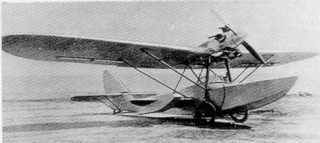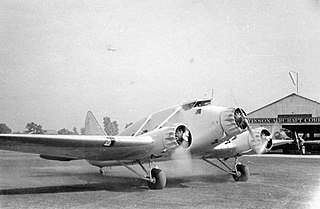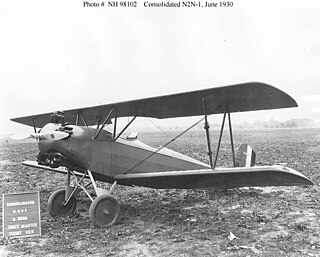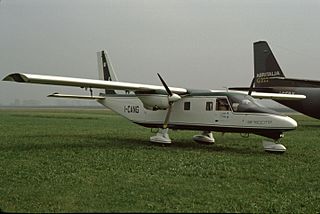
The Convair XC-99, AF Ser. No. 43-52436, is a prototype heavy cargo aircraft built by Convair for the United States Air Force. It was the largest piston-engined land-based transport aircraft ever built, and was developed from the Convair B-36 Peacemaker bomber, sharing the wings and some other structures with it. The first flight was on 24 November 1947 in San Diego, California, and after testing it was delivered to the Air Force on 26 May 1949. The Convair Model 37 was a planned civil passenger variant based on the XC-99 but was not built.
The Lockheed Model 10 Electra is an American twin-engined, all-metal monoplane airliner developed by the Lockheed Aircraft Corporation in the 1930s to compete with the Boeing 247 and Douglas DC-2. The type gained considerable fame as one was flown by Amelia Earhart on her ill-fated around-the-world expedition in 1937.

The Aermacchi AL-60 is a light civil utility aircraft of the late 1950s and early 1960s, originally designed by Al Mooney of Lockheed in the United States. After the company decided not to build the aircraft in the US, it was manufactured in small quantities in Mexico, and a few were assembled in Argentina by Aviones Lockheed-Kaiser Argentina. It was also built in quantity under licence by Aermacchi in Italy and Atlas Aircraft Corporation in South Africa.

The Curtiss Robin, introduced in 1928, was a high-wing monoplane built by the Curtiss-Robertson Airplane Manufacturing Company. The J-1 version was flown by Wrongway Corrigan who crossed the Atlantic after being refused permission.

The Piaggio PD.808 was an Italian business jet built by Piaggio. It was designed as a joint venture between Piaggio and Douglas Aircraft Company of Long Beach, California, United States.

The Lockheed Model 12 Electra Junior, more commonly known as the Lockheed 12 or L-12, is an eight-seat, six-passenger all-metal twin-engine transport aircraft of the late 1930s designed for use by small airlines, companies, and wealthy private individuals. A smaller version of the Lockheed Model 10 Electra, the Lockheed 12 was not popular as an airliner but was widely used as a corporate and government transport. Several were also used for testing new aviation technologies.
The Yakovlev Yak-25 was a Soviet military aircraft, an early turbojet-powered fighter aircraft designed by the Yakovlev OKB. The designation was later reused for a different interceptor design. Tasked by the Council of Ministers in a directive issued on 11 March 1947, with producing a straight winged fighter similar to the earlier Yak-19, but powered by a Rolls-Royce Derwent V, OKB-115 swiftly produced the Yak-25, which blazed several trails as the first Soviet fighter with a fully pressurised cockpit, air conditioning, jettisonable canopy, and hydraulic airbrakes on the fuselage amongst other innovations.

The Shavrov Sh-2 was a 1930s Soviet amphibious sesquiplane flying boat developed from the Sh-1, with a more powerful engine, slightly increased size and amphibious undercarriage. The Sh-2 could carry three people including the crew.

The Stinson Model A was a moderately successful airliner of the mid-1930s. It was one of the last commercial airliners designed in the United States with a fabric-covered steel tube fuselage before the introduction of stressed skin aluminum construction.

The Bellanca 31-40 Senior Pacemaker and its derivatives were a family of a six- and eight-seat utility aircraft built in the United States in the late 1930s. They were the final revision of the original late 1920s Wright-Bellanca WB-2 design. The model numbers used by Bellanca in this period reflected the wing area and engine horsepower, each divided by ten. Like their predecessors, these were high-wing braced monoplanes with conventional tailwheel undercarriage.

The Fleet Model 1 and its derivatives were a family of two-seat trainer and sports biplanes produced in the United States and Canada in the 1920s and 1930s. They all shared the same basic design and varied mainly in their powerplants.

The Dayton-Wright T-4 Messenger was a light, single-seat reconnaissance aircraft built in the United States by the Dayton-Wright Company in 1918 in the hope of gaining a production contract from the United States Army. It was a small conventional single-bay biplane with a neatly streamlined fuselage and staggered, equal-span wings. The undercarriage was of fixed tailskid type and the pilot sat in an open cockpit. Although diminutive, the design in fact started life as a scaled-up version of the Dayton-Wright Bug and shared a family resemblance to the de Havilland DH.4 that Dayton-Wright was building under licence during World War I. When the US Army was not interested in the aircraft, plans were made to sell it on the civil market, but these came to nothing and the prototype was the only example ever built.

The Dayton-Wright RB-1 , also known simply as the Dayton-Wright Racer was a high wing single-engine monoplane racing aircraft developed in the United States to participate in the 1920 Gordon Bennett Cup air race.

The Potez 840 was a 1960s French four-engined 18-passenger executive monoplane, the last aircraft to use the Potez name.

The Vulcanair SF.600 Canguro was a feederliner developed in Italy in the late 1970s. Despite a number of attempts to put the aircraft into series production, only a small number were ever built. The Canguro was a high-wing cantilever monoplane of conventional configuration with a fuselage of rectangular cross-section and a high-set tail. The tricycle undercarriage was not retractable, and its main units were carried on sponsons on the fuselage sides. SIAI Marchetti provided funding towards the construction of the prototype, and constructed this aircraft at the former Aviamilano plant. After flight testing proved positive, the type was put on sale, but failed to attract buyers in any number, even when the original piston engines were exchanged for turboprops and retractable undercarriage was offered as an option.
The ICP Vimana is a single engine, two seat, high wing, light aircraft with STOL capability. Designed and built in Italy by ICP srl, it was introduced in 2006.

The Consolidated XB2Y was an American prototype single-engined dive bomber of the 1930s. It was intended to meet a United States Navy requirement for a carrier-based dive bomber, but was unsuccessful, only a single example being built.

The Nord 260, built in prototype form as the Max Holste MH.260 Super Broussard,, was a turboprop-powered, uprated version of the piston-engined Max Holste MH.250 Super Broussard, that was further developed into the Aérospatiale N 262.

The Stinson Model R was an American light aircraft built by the Stinson Aircraft Company in the early 1930s. It was a single-engine high-winged monoplane, developed from the Stinson Junior. 39 units were built.

The Vega Model 2 Starliner was a prototype five-seat feeder airliner produced by the Vega Airplane Company, a subsidiary of Lockheed. It was designed to be powered by an unusual powerplant, consisting of two Menasco piston engines coupled together to drive a single propeller. A single example was built, flying in 1939, but no production followed.



















